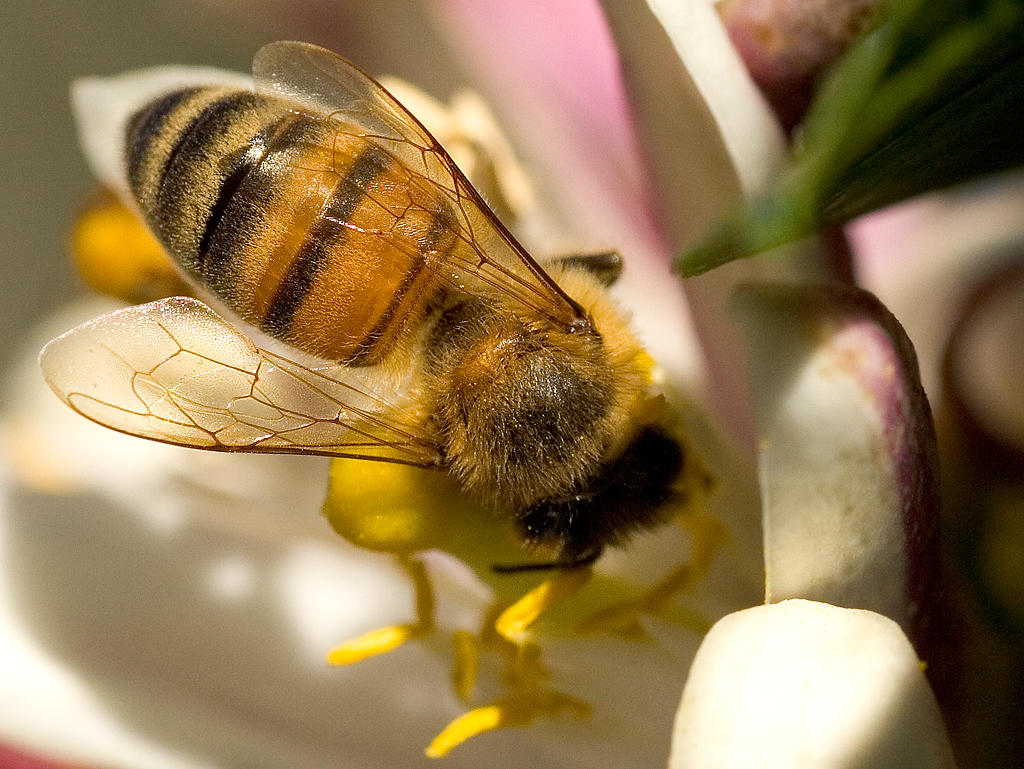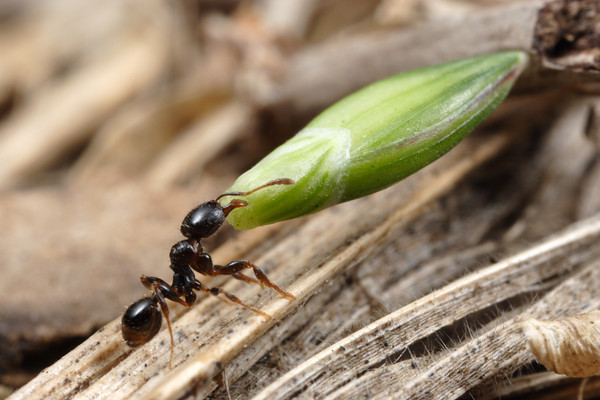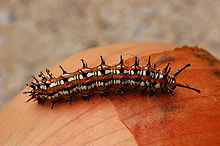"The modest, lowly violet in leaves of tender green is set; so rich she cannot hide from view, but covers all the bank with blue." -- Dora Read Goodale
Interactions
Viola sororia is involved mainly in mutualistic symbioses, in which both organisms benefit from their interaction with each other.
 One evident interaction is that of insect pollination. For most
flowers, when a bee arrives at the nectar site, it must touch the
anther to pick up the pollen on it. However, this does not happen in
Viola sororia. As the insect sticks its head in for nectar,
its wiggling movements cause pollen grains from the partly hidden
anthers overhead to drop and dust the bee's back. In this
interaction, the bee benefits by getting its food, while the plant
now has a means for dispersing its pollen for reproduction in other
areas. Insect pollination rarely occurs in Viola sororia,
but there are some bees that do interact with the species, such as
the Mason bees and Halictid bees. Because of this small chance of
insect pollination, the
cleistogamous flowers are very essential for
reproduction.
One evident interaction is that of insect pollination. For most
flowers, when a bee arrives at the nectar site, it must touch the
anther to pick up the pollen on it. However, this does not happen in
Viola sororia. As the insect sticks its head in for nectar,
its wiggling movements cause pollen grains from the partly hidden
anthers overhead to drop and dust the bee's back. In this
interaction, the bee benefits by getting its food, while the plant
now has a means for dispersing its pollen for reproduction in other
areas. Insect pollination rarely occurs in Viola sororia,
but there are some bees that do interact with the species, such as
the Mason bees and Halictid bees. Because of this small chance of
insect pollination, the
cleistogamous flowers are very essential for
reproduction.
Other insects that are sometimes attracted to the flowers of Viola sororia include skippers and Syrphid flies. However, the Syrphid flies are non-pollinating because they feed only on stray pollen. This symbiosis can be classified as a commensalism, an interaction in which only one of the symbionts benefit, but the other one is not intimately harmed either.
 Another mutual interaction that Viola sororia engages in
is its interaction with some species of ants. This symbiotic
relationship is called myrmecochory, which literally means "ant
farming." In this interaction, the ants are drawn to ripe seeds of
Viola sororia by small protuberances called elaiosomes that
contain attractive oils and possibly sugars. These ants will carry
the seeds to their nests where they eat. However, the shell is
too hard to open, so after eating, they will discard the seed
proper, often into an unused tunnel in the nest. In this tunnel, the
seed has a much better chance of producing a plant due to the
nutrients provided by the soil and housecleaning ants. In addition,
the seed is protected from foraging birds and rodents that pick up
seeds dropped on the open forest floor. In some environments, by
engaging in myrmecochory, the seeds of Viola sororia are
protected from wildfires, as well. Other organisms that involve in this symbiosis include
trilliums, bloodrot,
anemones, wild ginger, and hepaticas.
Another mutual interaction that Viola sororia engages in
is its interaction with some species of ants. This symbiotic
relationship is called myrmecochory, which literally means "ant
farming." In this interaction, the ants are drawn to ripe seeds of
Viola sororia by small protuberances called elaiosomes that
contain attractive oils and possibly sugars. These ants will carry
the seeds to their nests where they eat. However, the shell is
too hard to open, so after eating, they will discard the seed
proper, often into an unused tunnel in the nest. In this tunnel, the
seed has a much better chance of producing a plant due to the
nutrients provided by the soil and housecleaning ants. In addition,
the seed is protected from foraging birds and rodents that pick up
seeds dropped on the open forest floor. In some environments, by
engaging in myrmecochory, the seeds of Viola sororia are
protected from wildfires, as well. Other organisms that involve in this symbiosis include
trilliums, bloodrot,
anemones, wild ginger, and hepaticas.
 Viola
sororia is also involved in many other interactions. One is
with the caterpillars of many Fritallary butterflies, in which the
caterpillars feed on foliage leaves of Viola sororia. These
butterflies include Speyeria diane (Diana), Euptoieta
claudia (Variegated Fritillary), Speyeria aphrodite
(Aphrodite Fritillary), Boloria bellona (Meadow Fritillary),
and Boloria selene myrina (Silver-Border Fritillary).
Occasionally, wild upland gamebirds and small mammals eat the seeds.
These organisms include Wild Turkey, which also eat the leaves and
fleshy roots of violets, Bobwhite, Mourning Dove,
and the White-Footed Mouse.
Viola
sororia is also involved in many other interactions. One is
with the caterpillars of many Fritallary butterflies, in which the
caterpillars feed on foliage leaves of Viola sororia. These
butterflies include Speyeria diane (Diana), Euptoieta
claudia (Variegated Fritillary), Speyeria aphrodite
(Aphrodite Fritillary), Boloria bellona (Meadow Fritillary),
and Boloria selene myrina (Silver-Border Fritillary).
Occasionally, wild upland gamebirds and small mammals eat the seeds.
These organisms include Wild Turkey, which also eat the leaves and
fleshy roots of violets, Bobwhite, Mourning Dove,
and the White-Footed Mouse.
Everything so far as been quite intriguing, huh?! To find out more interesting facts about the Common Blue Violet, head on over to the Facts page! You will also find out how humans use wood violets! Be prepared to be amazed at how much we can potentially do with these organisms!